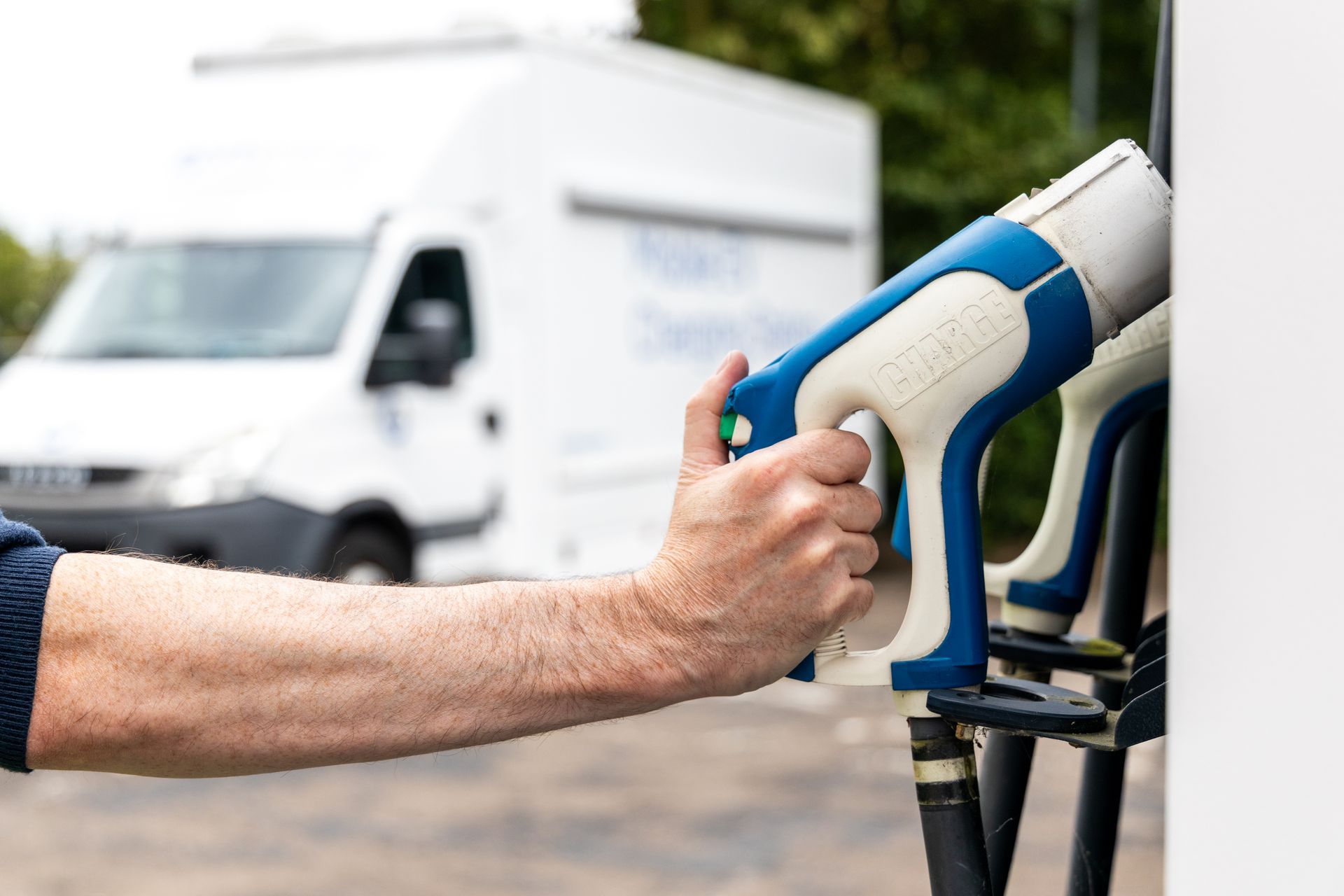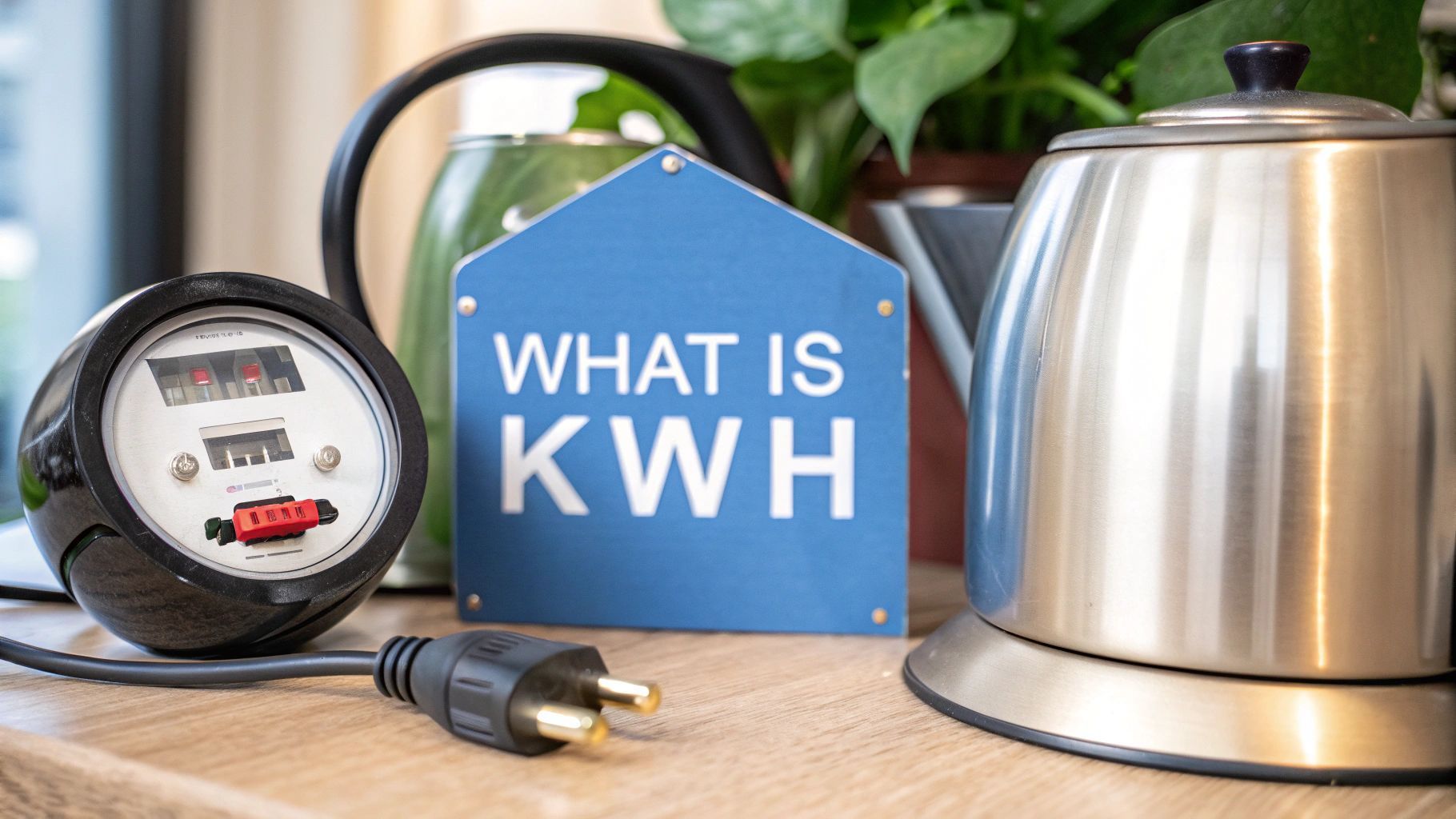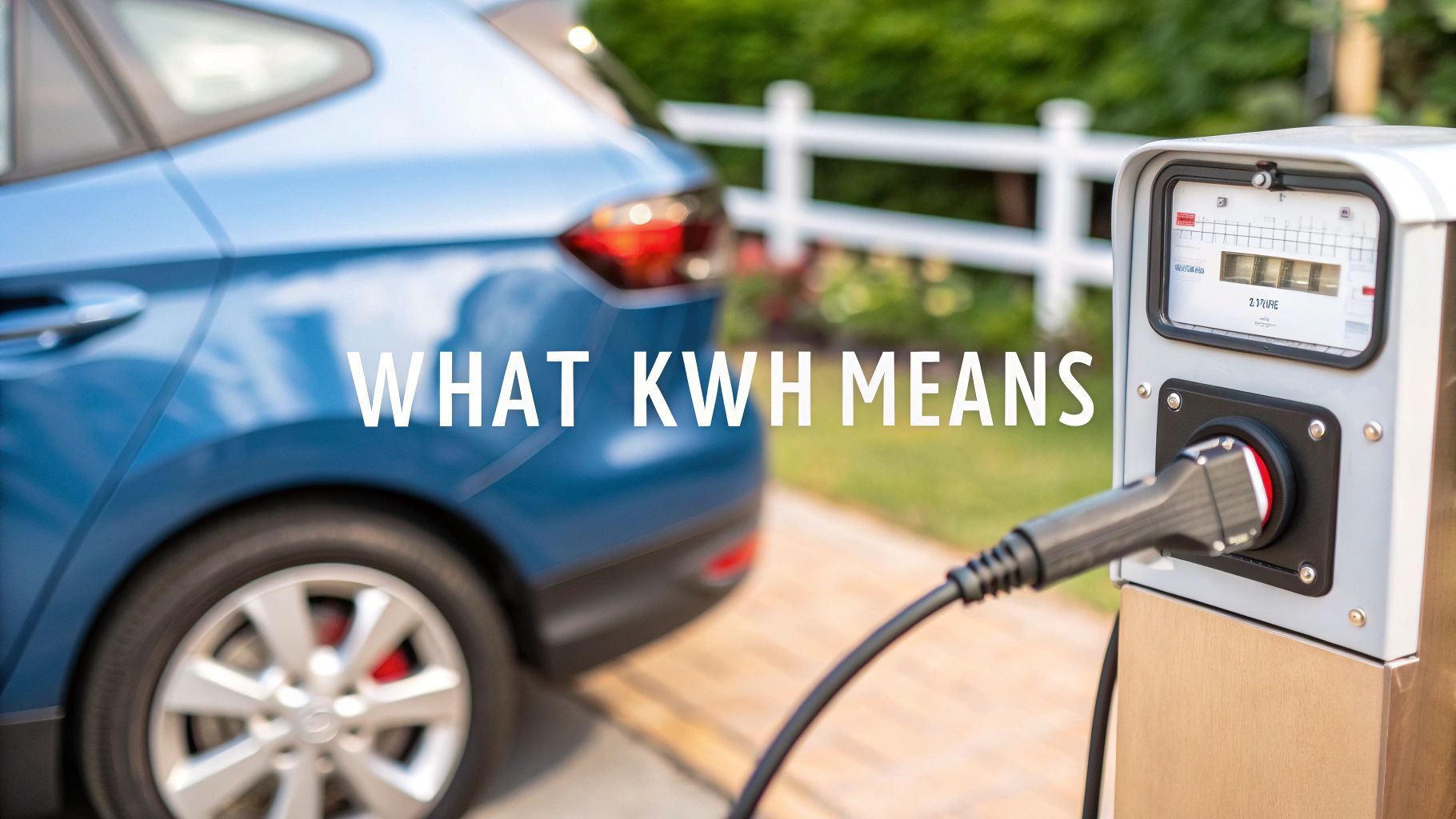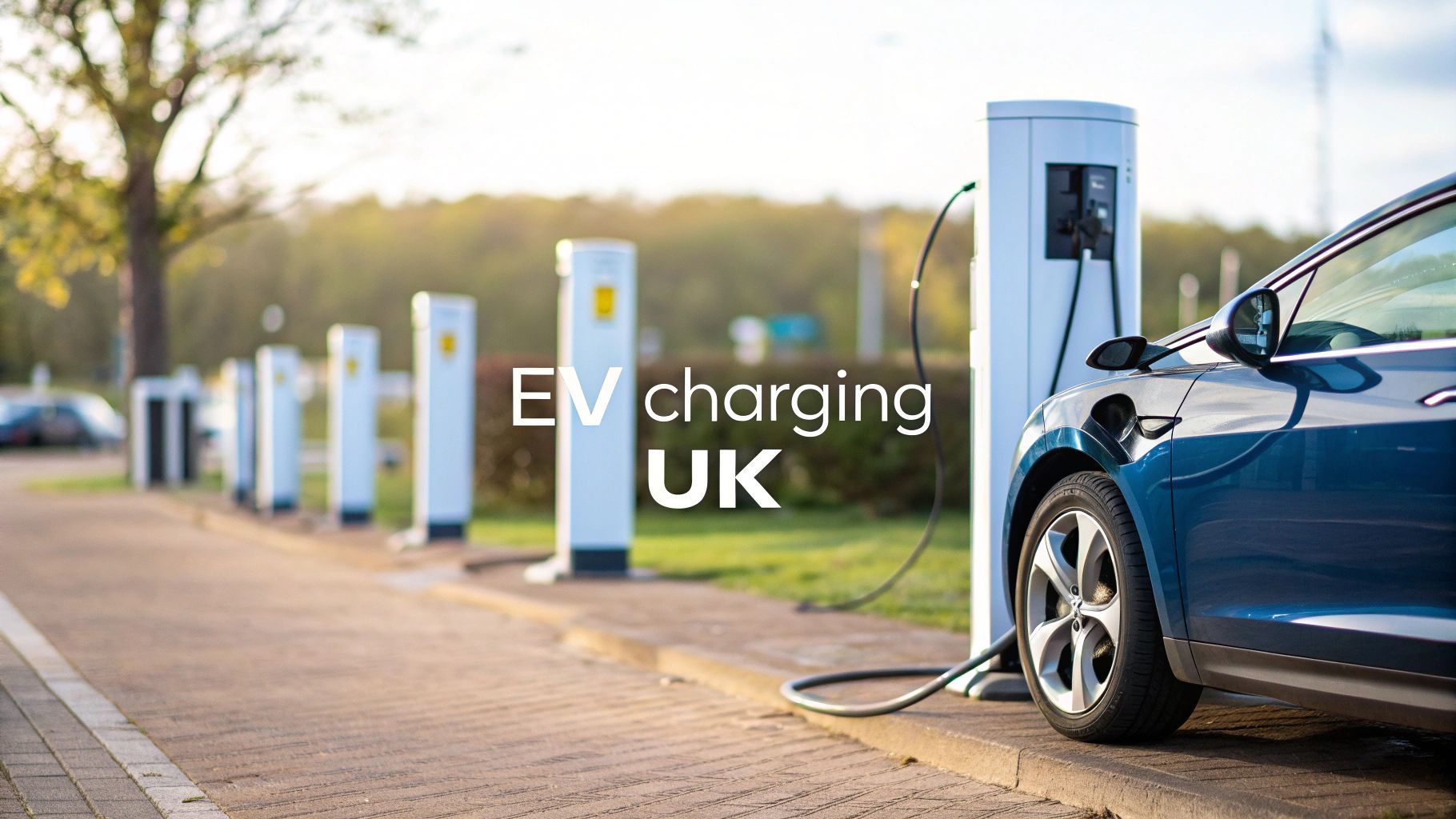EV Charger Extension Cable: A Complete Guide
An EV charger extension cable is a purpose-built, heavy-duty lead designed to safely bridge the gap between your electric vehicle and a charging point. Think of it as a crucial accessory for any driver who has ever found themselves just a bit too far from the plug.
Why Your Standard EV Cable Is Not Always Enough
Let's be honest: the standard cable that came with your electric vehicle does not always cut it. Many UK drivers know the real-world frustration of a home charge point installed on the wrong wall or arriving at a public charger only to find it blocked by an inconsiderately parked car. This is where an EV charger extension cable transforms from a simple accessory into an indispensable tool.
Imagine arriving at a friend's house, only to find their driveway charger is just out of reach. Or picture yourself navigating a crowded car park where the only available charging bay is two spaces away. These are the kinds of common, everyday scenarios that highlight the limits of a standard-length cable. An extension gives you the crucial extra length you need to bridge that gap, offering peace of mind and putting an end to charging anxiety.
Overcoming Everyday Charging Hurdles
As the UK embraces electric mobility, the need for more flexible charging options is growing. The rapid expansion of e-mobility solutions puts more pressure on the existing infrastructure and even with impressive growth in public charge points, you can still find yourself in a tricky situation.
Consider these all-too-common challenges:
- Blocked Public Chargers: A non-EV has parked in the charging bay, completely blocking access.
- Awkward Home Setups: Your off-street parking spot is just a little further from the house than your cable can stretch.
- Visiting Friends or Family: Their charger is accessible but it is not quite close enough for your standard lead to connect.
An extension cable solves these problems in an instant. This simple tool offers more than just convenience; it provides the flexibility you need to confidently use the UK’s expanding charging network. While the infrastructure continues to grow, having a backup plan is just smart—especially for those who cannot rely on dedicated home charging options.
The UK's public charging network is expanding at a phenomenal rate, with the total number of chargers hitting 86,021 as of October 2025. That represents a 23% increase in just one year, showing that a new charge point is being added approximately every 33 minutes across Britain.
Decoding the Different Types of Extension Cables
Feeling lost in a sea of technical terms? You are not alone. Choosing an EV charger extension cable can seem complex but it is straightforward once you understand the key differences. The most important distinction lies in the connector types used across the electric vehicle market.
In the UK and Europe, the Type 2 connector is the universal standard for AC charging. Almost every new electric car and public AC charger uses this seven-pin plug. You might still see a Type 1 connector on older vehicles or imports from North America and Asia but these are becoming increasingly rare on British roads.
For this reason, a Type 2 to Type 2 extension cable is the default choice for the vast majority of UK drivers. You can find more details in our complete guide to every EV charger connector.
This helpful infographic illustrates how a simple extension cable can solve the common problem of a blocked public charger.

As the diagram shows, an EV charger extension cable is the direct solution when physical obstacles prevent you from parking right next to a charge point.
Understanding Power Ratings and Amperage
Beyond the plug type, you will see ratings for amperage (A) and kilowatts (kW). Think of amperage as the flow rate of electricity, like water through a hose. A 16A cable is a common entry-level option suitable for slower overnight charging whilst a 32A cable allows for a faster flow, doubling the potential charging speed.
The power rating in kW is simply the result of amperage multiplied by voltage. Here’s what that means for your charging times:
- 16A Single-Phase: Delivers up to 3.7kW of power, ideal for plug-in hybrids or slower top-ups.
- 32A Single-Phase: Provides up to 7.4kW , which is the standard for most home wall boxes and many public AC chargers.
- 32A Three-Phase: Can deliver up to 22kW , offering much faster charging but requires both the car and the charge point to support three-phase power.
For most UK homes, a 32A single-phase cable is the most practical and versatile choice.
To help you decide, here’s a quick comparison of the most common Type 2 extension cables.
Comparing Type 2 EV Charger Extension Cable Specifications
| Specification | 16A Single-Phase | 32A Single-Phase | 32A Three-Phase |
|---|---|---|---|
| Max Power Output | Up to 3.7kW | Up to 7.4kW | Up to 22kW |
| Best For | PHEVs, overnight charging | Most home wall boxes, public AC chargers | Fast AC charging, commercial properties |
| Typical Use Case | Topping up at home or work | Standard everyday charging | Maximising speed at compatible locations |
| Charging Speed | Slowest | Standard (most common) | Fastest (AC only) |
Choosing the right cable ensures you are not creating a bottleneck and can take full advantage of the power available from the charge point.
Choosing the Right Cable Length
The final piece of the puzzle is length. Cables typically range from 5 to 15 metres .
A shorter 5m cable is compact and easy to store but might not be long enough for tricky parking situations. A 10m cable offers a great balance of reach and manageability. While a 15m cable provides maximum flexibility, it will also be heavier and bulkier to handle.
These cables have become a key part of the UK's charging ecosystem, born from the practical needs of a rapidly expanding infrastructure. To keep everyone safe, UK regulations demand that extension cables meet strict specifications, including a cable thickness of at least 3.5mm² for Type 2 variants to handle high power loads without overheating.
How to Choose the Right Extension Cable

Picking the right EV charger extension cable is not just about getting the longest one you can find. To make a smart investment, you need to match the cable’s specs to your car and how you actually charge it. This is the only way to ensure you end up with a solution that is compatible, safe and genuinely useful.
First things first, check your car’s onboard charger capacity. This is the maximum AC charging speed your vehicle can handle and it is a hard limit. For instance, if your EV can only accept 7.4kW , buying a beefy 22kW -rated cable will not magically make it charge any faster. You are simply future-proofing your purchase for a future car.
On the flip side, using an under-rated cable creates an immediate bottleneck. Let’s say you plug your 7.4kW -capable car into a 7.4kW public charger but use a 3.6kW extension cord. Your charging speed will be stuck at 3.6kW . Always aim to match or exceed your car's and charger's power rating to get the speed you are paying for.
Match the Cable to Your Charging Environment
Next, think about where you will be using this cable most of the time. Your primary charging spot really dictates the features you should be looking for. Is it for your private driveway with a wallbox or are you expecting to use it at all sorts of public stations?
- For Home Use: If you just need a bit of extra length to reach your parking spot from a home charger, a durable cable without extreme weatherproofing might be perfectly fine. You are in control of the environment, after all.
- For Public Charging: If you are a road warrior planning to use it frequently out and about, then durability and weather resistance are non-negotiable. You never know what conditions you will find at a public charge point.
The need for this kind of flexibility is more common than you might think. UK surveys show that 40-50% of EV owners have been stuck in situations where a longer cable would have saved the day, especially in residential areas where your parking spot is not always next to your charger. This has fuelled growth in the EV accessory market, giving drivers more choice. You can find out more by exploring the latest UK government electric vehicle infrastructure statistics.
Prioritise Build Quality and Safety Ratings
Finally, never, ever compromise on build quality. A well-made EV charger extension cable is a crucial piece of safety equipment, not just a simple wire. The quality of the plugs, the locking mechanisms and the cable’s outer sheath are vital for both longevity and safe operation.
A key indicator of a cable's resilience is its Ingress Protection (IP) rating. This two-digit number tells you how well the equipment is protected against solids (like dust) and liquids (like rain).
Look for a minimum rating of IP55 . The first ‘5’ means it is protected against dust whilst the second ‘5’ confirms it can handle low-pressure water jets from any direction. That makes it more than suitable for typical British weather, giving you peace of mind when charging outdoors. A higher rating like IP65 offers even better protection. Investing in a robust, weather-resistant cable is essential for reliable charging, come rain or shine.
Essential Safety Rules for Using Your Cable
When you are dealing with the high-power electronics of an electric vehicle, safety has to come first. An EV charger extension cable is a purpose-built, safe tool but using it correctly is non-negotiable for protecting yourself, your car and your property. Think of it less like a simple domestic lead and more like a specialist piece of electrical equipment that deserves a bit of respect.
The golden rule, and the one you should never break, is to avoid using a standard household extension lead to charge your car. Those common orange or white cables are designed for low-power items like a lawnmower or a lamp, not the sustained, high-amperage load an EV demands. Trying to use one can cause it to overheat dramatically, melt its insulation and create a very real fire hazard.
An EV-specific extension is built differently, with much thicker internal wiring and robust connectors designed to handle that continuous power flow for hours on end. It is probably the most dangerous mistake a new EV owner can make.
Best Practices for Safe Charging
A few simple habits can ensure every charge is a safe one. These steps are quick and easy but they make a massive difference in preventing accidents and keeping your gear in good nick. A minute of preparation can genuinely prevent serious problems down the line.
Start with a quick visual check before each use. Look for any signs of damage on the cable, like cracks, exposed wires or bent pins in the connectors. If you spot anything that looks even slightly off, do not use it.
One of the most overlooked safety steps is to always uncoil the cable fully before you start charging. A coiled cable can act like an electrical inductor, trapping heat and potentially leading to dangerous overheating, even if the cable itself is in perfect condition.
This heat build-up, sometimes called thermal runaway, can damage both the cable and your car's charging port. Always lay the cable out straight and make sure it is not a trip hazard for anyone walking past.
Understanding Weather and Storage
Charging in the unpredictable British weather means you need to know what your cable can handle. This is where the IP (Ingress Protection) rating comes into play.
Here’s a quick rundown of what those numbers mean:
- IP44: Protected from splashing water. This is fine for light rain but you will want to avoid heavy downpours or leaving it in puddles.
- IP55: Protected from low-pressure water jets from any direction. This is a good, solid standard for reliable outdoor use in most weather.
- IP65/67: Offers even stronger protection against powerful water jets and can even handle being temporarily dunked in water.
Proper storage is just as important as how you use it. When you are done charging, always disconnect the plug from the car first, then unplug from the charge point. Pop the connector covers back on to keep out dust and moisture. Storing your EV charger extension cable in its protective bag, away from direct sunlight and extreme temperatures, will ensure your investment stays safe and effective for years.
Unlocking Mobile Charging Freedom and Profit

An EV charger extension cable is much more than just a wire. Think of it as the key that unlocks a new level of freedom and for the savvy operator, a surprising source of income. Its most obvious advantage is simple: it puts an end to range anxiety. You are no longer tethered to perfectly placed charge points.
This newfound flexibility completely changes how you think about charging. Suddenly, you can visit friends with awkwardly positioned chargers without a second thought or grab the last bay in a busy car park, even if it is a few metres further away than ideal. It gives you the power to charge almost anywhere, taking the stress out of the equation.
But the real story goes beyond personal convenience. For anyone with an entrepreneurial streak, this humble cable can be the foundation of a mobile charging service. It allows you to sell electricity on the go, turning your EV and its accessories into a genuine business asset.
Turning Flexibility into Financial Gain
The demand for on-the-spot EV charging is exploding. Getting fixed charging points installed can take months, sometimes years, thanks to planning permissions and grid connection headaches. This frustrating delay has opened up a huge gap in the market for mobile, agile solutions.
Just imagine the possibilities:
- Mobile Mechanic: You could offer an emergency top-up to a client whose EV has run flat, adding a unique and valuable service that sets you apart.
- Event Organiser: Set up temporary charging stations at festivals, outdoor markets or concerts. EV drivers will flock to you and you can charge a premium for the convenience.
- Fleet Support: Provide a mobile top-up service to local businesses with electric vans, making sure their fleet is always ready to roll.
This approach completely sidesteps the massive upfront costs and logistical nightmares of installing permanent chargers. You become a self-contained charging solution, ready to operate wherever there is a need. You can dive deeper into how to profit with a portable charging station for electric cars in our detailed guide.
The Economics of Mobile Charging
Let’s break down what the return on your investment could look like. A high-quality extension cable and a portable power bank are a modest outlay compared to the eye-watering cost of fixed infrastructure. By providing a vital service to stranded drivers or event-goers, you can set a fee that quickly covers your initial cost and starts generating pure profit.
The business model is refreshingly simple: buy electricity at your low domestic rate and sell it at a premium where it is needed most. It is a clear arbitrage opportunity that creates a reliable revenue stream from a single piece of kit.
For instance, offering a 10-15 kWh emergency boost—good for about 40-60 miles of range—could be priced based on convenience and urgency. Selling this service to just five customers a week at a profitable margin could generate over £10,000 a year. This transforms an accessory you bought for convenience into a powerful tool for making your EV work for you.
Your Questions Answered
We get asked a lot about EV charger extension cables, so we’ve put together this final section to clear up any lingering questions. Think of it as your quick-reference guide to making a confident decision.
Can I Just Use a Normal Extension Lead for My EV Charger?
Absolutely not. You must never use a standard household extension cable to charge your electric vehicle. They simply are not built to handle the high, continuous power load an EV needs and can easily overheat, creating a serious fire risk.
Always stick to a purpose-built EV charger extension cable that fits your car's connector and is rated for the right amperage.
Will an Extension Cable Make My Car Charge Slower?
A high-quality, correctly rated extension cable should not slow down your AC charging speed in any noticeable way.
However, a very long or underrated cable might cause a slight voltage drop which could marginally slow things down. The simple rule is to always choose a cable rated to at least the maximum power your charger and vehicle can handle.
Is It Safe to Use an EV Charger Extension Cable in the Rain?
Yes, as long as you are using a cable with a suitable IP (Ingress Protection) rating. Look for IP55 or higher , which confirms it is protected against dust and jets of water from all directions—perfect for typical British weather.
That said, never submerge the connectors in water and always double-check they are securely clicked into place before you walk away.
How Do I Look After My Extension Cable?
A little care goes a long way. To keep your cable in top shape, always uncoil it fully during use to prevent heat build-up. When you are done charging, disconnect from the car first, then the charge point.
Every so often, give the connectors a wipe with a dry cloth. And of course, try not to run over the cable! Store it in its protective bag, away from extreme heat or cold and it will stay safe and effective for years.
Take control of your charging with ZAPME 's portable and mobile EV charging solutions. Discover how you can power your EV anywhere or even start your own mobile charging business today. Visit https://www.zapme.biz to learn more.











